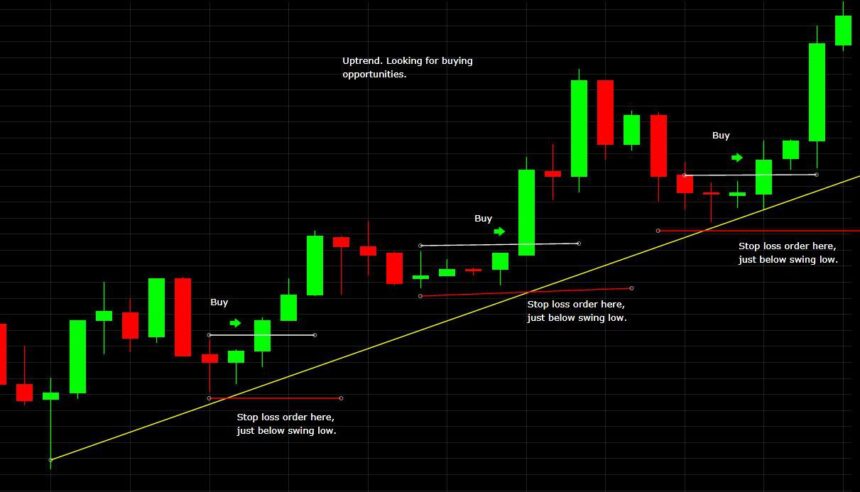Investing in the stock market is an expedition that transforms a novice into a seasoned investor. One pivotal strategy that aids in this transformation is the effective use of trailing stops. This tool not only helps in protecting gains but also minimizes losses, a dual benefit that is crucial for long-term success in trading. This article delves into the essence of trailing stops, offering insights on how investors can leverage this strategy for enhanced financial outcomes.
Understanding Trailing Stops
A trailing stop is a directive to sell a deposit if it moves in an unfavorable direction. Still, unlike a standard stop loss, it moves with the demand price when the market moves in a favorable direction. It is set at a percentage or dollar amount away from the current market price; if the price moves favorably, the trailing stop moves with it, maintaining the set distance. This mechanism ensures that investors can secure profits while potentially limiting losses without the need to manually adjust their stop-loss orders.
The Mechanics Behind Trailing Stops
To implement a trailing stop, an investor must decide on the distance (either in percentage or absolute value) that the stop will trail the market price. For example, setting a 5% trailing stop on a stock purchased at $100 means the sell order is initially placed at $95. If the stock price increases to $110, the trailing stop adjusts to $104.50, maintaining the 5% gap. This adjustment occurs automatically as the stock price fluctuates, offering a dynamic approach to risk management.
Strategic Advantages of Trailing Stops
Locking in Profits While Mitigating Risk
Enhanced Control Over Investment Outcomes: Trailing stops offer investors a higher degree of control over their investment outcomes by automatically adjusting to market conditions. This proactive approach to portfolio management ensures that gains are protected and optimized according to market performance.
Flexibility Across Market Conditions: The versatility of trailing stops makes them applicable across a variety of market conditions. Whether in a bullish trend where securing incremental gains becomes crucial, or in bearish scenarios where limiting losses is paramount, trailing stops adjust to safeguard investments.
Emotion-Free Decision Making
Facilitating Consistent Strategy Implementation: The use of trailing stops helps in the consistent application of trading strategies. Automating the sell process based on specific criteria ensures that strategic decisions are executed without delay, avoiding missed opportunities due to indecision or hesitation.
Supporting Long-Term Investment Goals: The discipline enforced by trailing stops aligns closely with long-term investment objectives. By systematically securing profits and preventing significant losses, it contributes to the gradual achievement of financial goals, minimizing the impact of short-term market fluctuations on long-term aspirations.
Implementing Trailing Stops: Best Practices
Choosing the Right Trailing Amount
One of the critical decisions in using trailing stops is selecting the appropriate trailing amount. Setting it too tight might result in being stopped out prematurely during normal market fluctuations, while a too wide stop might expose you to unnecessary risk. The key is to find a balance that aligns with your risk tolerance and the stock’s volatility.
Utilizing Trailing Stops in Different Market Conditions
Trailing stops can be particularly effective in trending markets, where they allow profits to run while cutting losses. In sideways or highly volatile markets, however, they might require more frequent adjustments to avoid being triggered by normal price swings. Adapting trailing stops to current market conditions is crucial for maximizing their effectiveness.
Moving Beyond the Basics
Advanced Trailing Stop Strategies
For those looking to deepen their understanding of trailing stops, exploring advanced strategies that involve moving averages, percentage-based stops, and volatility-adjusted stops can offer nuanced ways to manage risk. Each approach has unique advantages, catering to different investment styles and objectives.
Integrating Trailing Stops with Other Investment Strategies
Trailing stops are most effective as part of a broader investment strategy. Combining them with thorough research, diversification, and a clear understanding of market signals can enhance their utility, offering a more holistic approach to investment risk management.
Conclusion
Trailing stops are a powerful tool in the arsenal of both novice and experienced investors, providing a dynamic way to manage risk while pursuing greater gains. By understanding and implementing this strategy effectively, investors can navigate the complexities of the market with greater confidence, making informed decisions that align with their financial goals. As with any investment strategy, the key to success lies in education, discipline, and a willingness to adapt to changing market conditions. Through careful planning and execution, trailing stops can play a vital role in the journey from novice to pro, helping investors safeguard their portfolios while capturing the upside potential of their investments.






